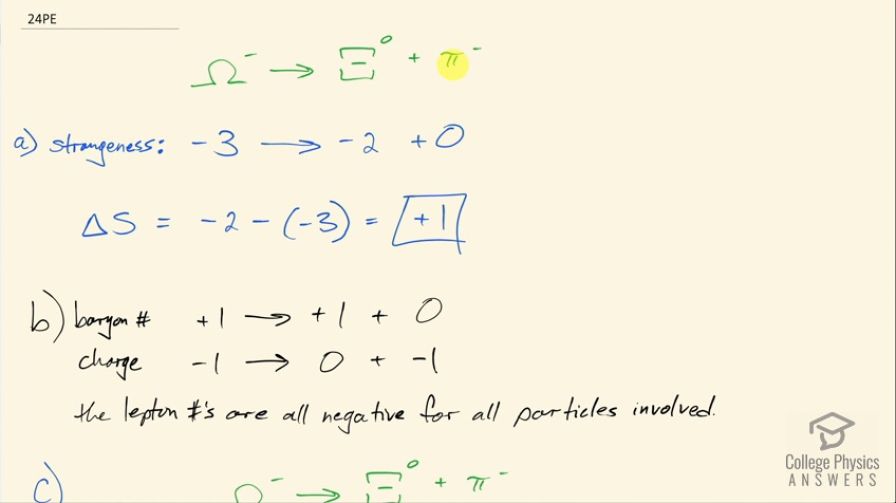Question
One of the decay modes of the omega minus is
(a) What is the change in strangeness?
(b) Verify that baryon number and charge are conserved, while lepton numbers are unaffected.
(c) Write the equation in terms of the constituent quarks, indicating that the weak force is responsible.
Final Answer
- +1
- Please the solution video
- Please see the solution video.
Solution video
OpenStax College Physics, Chapter 33, Problem 24 (Problems & Exercises)

vote with a rating of
votes with an average rating of
.
Video Transcript
This is College Physics Answers with Shaun Dychko. The omega minus particle can decay into a neutral xi particle plus a negative pion. Part (a) asks us to calculate what the change in strangeness is? So the omega minus particle has a strangeness of minus 3 and we look that up in this table [33.2] and we see that the omega minus particle has a strangeness of 3— where this column here is the strangeness column— and that turns into this neutral xi particle that has a strangeness of negative 2 and a negative pion, which has a strangeness of 0 and so we can see that the change in strangeness, which is the final strangeness minus the initial strangeness so negative 2 minus negative 3 has a change in strangeness of positive 1. Part (b) asks us to verify that baryon number and charge are conserved. So the baryon number for the omega minus particle is positive 1 as we can tell from here— this is the baryon number column— and the neutral xi particle has a baryon number of positive 1 as well and a pion has a baryon number of 0 and so that's conserved because it's 1 on both sides. The charge of this negative omega particle is negative 1 and the xi particle is neutral so its charge is 0 and the negative pion has a charge of negative 1 so we have negative 1 on both sides so that's conserved and the lepton numbers are all zero— not negative—they are all zero for all the particles involved here and we can verify that from this table here we have 0, 0, 0 and 0s here and then 0s for the pion as well for these three columns, these are the three different lepton numbers. Okay! So that's good! Then in part (c), we talk about this decay in terms of quarks to show that there is change in quark flavor, a change in strangeness and so this negative omega particle is made up of three strange quarks and after the decay, we end up with two strange quarks and an up quark in this neutral xi particle and then we have an up anti-quark and a down quark and a negative pion and this is a result or what this shows is that there's a change in strangeness... I mean it's telling us the same thing we found in part (a), there's a plus 1 in strangeness each strange quark contributing a strangeness of negative 1 so here we have a total of negative 3 here and only negative 2 here and 0 here for strangeness and the only force that can change quark flavor is the weak force and so this verifies that the weak force must be mediating this decay.